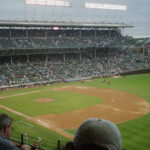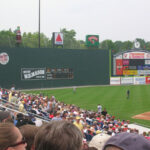Hitting is one-third of baseball, splitting importance with fielding and pitching. Most fans, however, pay the closest attention to hitters. Every time a home run is launched over the outfield fences, fans go wild. Of course, there are plenty of other hitting statistics that people play close attention to. For those that don’t know all of the statistics and measures, here are the basics.
G – Games. With 160 games per season, a player would like to be a part of every single one of them. Typically, a player that stays healthy through most or all of the season will appear in 130 games or more.
AB – At Bats. During each game, a batter should come up to the plate for at least three or four at bats, which means they’ll have over 400 at bats per season.
R – Runs. A run is scored each time a base runner crosses home plate, whether its through a base hit, walk, hit batter, or a home run. Scoring anywhere close to 100 runs in a single season is considered a great number for any batter.
H – Hits. In order to win score runs and win a baseball game, batters have to accumulate hits. Hits can be singles, doubles, triples, or home runs. A few batters will cross the 200 hit mark during a single season, which is a great number.
TB – Taken Bases. The total number of bases a batter takes is important. Walks, intentional walks, wild pitches, and being hit by a pitch count as a single base, as does a single. Therefore, doubles count as two bases, triples as three bases, and home run as four bases.
2B – Doubles. If a batter belts the ball out into the outfield and reaches second base, then they’ve got themselves a double. Of course, doubles are fairly common for all types of hitters, whether they are larger or smaller; faster or slower. Power hitters can manage doubles by belting the ball far out into the outfield.
3B – Triples. If a batter reaches third base on their own hit, then the hit gets recorded as a triple. Without a doubt, triples are the most uncommon hits in all of baseball (unless you consider inside-the-park home runs). A batter is more likely to homer than to land a triple because it takes a mix of power, speed, and luck to hit a triple. The best chance for any batter to hit a triple is for them to knock the ball into the outfield and then have the ball ricochet off the ground away from the outfielders. With enough luck, any batter can land a triple, but it rarely happens for most hitters.
HR – Home Runs. Everyone knows what a home run is: When the ball crosses the outfield fence or hits off the foul pole, everyone watching the game goes crazy. Another type of home run, the inside-the-park home run occurs if a batter hits the ball and is able to cross home plate on the hit. This happens a handful of times each season, but it’s extremely rare. With respect to taken bases, a home run counts for four. Home runs occur frequently for power hitters and less frequently for hitters with less strength in hitting.
RBI – Runs Batted In. With a runner in scoring position, the batter at the plate can get a hit and have the runner score to achieve an RBI. An RBI can be credited to a hitter when they get a hit and a base runner reaches home, a player gets a bases-loaded walk, or they hit a sacrifice fly or groundout. Also, a batter can hit a home run and they will be credited with an RBI for batting in their own run. Most power hitters want to achieve over 100 RBIs per season.
* RBIs usually aren’t counted if they are the result of an error.
BB – Bases on Balls. When a batter is thrown four balls, they get a walk and head to first base. Walks occur in every game and are a common occurrence. Batters would rather hit than walk, but walking is much better than striking out.
IBB – Intentional Bases on Balls. If a dominant batter or another hitter who has been hitting well lately is at the plate, a pitcher may choose to walk them intentionally. This is usually done to face a weaker batter that is more likely to result in an out if pitched to. IBB are a good strategy to avoid having runners in scoring position come home and score.
SO – Strikeouts. A called strike three or swinging strike three gets a hitter a strikeout. Nobody likes getting a strikeout, but it happens all the time. Power hitters strike out fairly often. Obviously, all batters want to avoid too many strikeouts each game or season.
SB – Stolen Bases. Whenever a base runner steals a base without an error, they get credited with a stolen base. Usually, only fast base runners steal bases, but any player can pull it off. Another type of stolen base is the straight-steal of home, which happens infrequently when a runner steals home without the aid of another runner stealing a base to distract the pitcher or catcher.
CS – Caught Stealing. Should a base runner attempt to steal and get picked-off or tagged out at the base, then they are considered to be caught stealing. Quick runners will rarely get caught stealing, but nobody is immune to being caught.
AVG – Batting Average. How often a batter gets a hit is their batting average. To get this statistic, you only need to take their total number of hits and divide it by the number of at bats they have had. A batter with an average over .300 is a really effective hitter. Anything above .250 is considered average.
OBP – On-Base Percentage. This represents how often a batter is able to reach base, whether it’s through a hit, walk, or other action that gets them on base.
SLG – Slugging Percentage. Divide a hitter’s total bases by their total at bats and you’ll have their slugging percentage. Batters want to have the highest possible slugging percentage.
OPS – On-base plus Slugging. Add OBP to SLG and you’ve got a hitter’s on-base plus slugging statistic. Obviously, a batter with a high OBP and SLG will have a high OPS.
There are plenty of other batting statistics out there, but these are the basic ones that every fan or spectator should at least have an idea about. Just about the only statistic a batter doesn’t want to have be high is the Strikeout or a high number of times caught stealing. Another common statistic for hitters is called sabermetrics, which is a collection of various other statistics.



